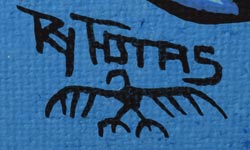Roy Thomas, Anishinaabe Painter
+ Add Artist to My Preferences
Roy Thomas (1949-2004): A Visionary of the Woodland Art Movement
 Roy Thomas (Gahgahgeh - "Crow") was a seminal figure in the Woodland art movement and stands as one of the most influential Indigenous painters of his generation. Born in 1949 near Pagwachuan Lake and raised on the Longlac Reserve in northwestern Ontario, Thomas's artistic journey was deeply rooted in his heritage. From a tender age, he was captivated by the traditional stories imparted by his grandmother, often sketching the vivid images they conjured in his mind. It was his grandparents who bestowed upon him the name Gahgahgeh, or "Crow," a personal emblem that would accompany his signature in many of his iconic works, stemming from his compassionate act of rescuing and raising an orphaned crow.
Roy Thomas (Gahgahgeh - "Crow") was a seminal figure in the Woodland art movement and stands as one of the most influential Indigenous painters of his generation. Born in 1949 near Pagwachuan Lake and raised on the Longlac Reserve in northwestern Ontario, Thomas's artistic journey was deeply rooted in his heritage. From a tender age, he was captivated by the traditional stories imparted by his grandmother, often sketching the vivid images they conjured in his mind. It was his grandparents who bestowed upon him the name Gahgahgeh, or "Crow," a personal emblem that would accompany his signature in many of his iconic works, stemming from his compassionate act of rescuing and raising an orphaned crow.
Thomas is widely regarded as a major force in the second generation of Woodland artists, a powerful movement founded by Norval Morrisseau in the 1960s and profoundly rooted in Anishinaabe visual traditions. While Morrisseau laid the foundational groundwork, Thomas developed a truly distinctive vision, making significant and lasting contributions to the evolution and widespread recognition of this unique artistic style.
His path was marked by both early talent and profound adversity. Thomas began drawing at the age of six and, like many Indigenous children of his era, attended a residential school. At just 13, he endured the devastating loss of both his parents and grandparents in a tragic car crash. After leaving school at 15, he navigated a period of travel and various jobs, confronting and ultimately overcoming alcohol addiction. A pivotal moment arrived at age 16 when he met Norval Morrisseau. Witnessing the elder artist paint on birchbark ignited a profound inspiration within Thomas, compelling him to fully embrace his own destiny as a painter.
Thomas's talent quickly gained recognition. He held his first solo exhibition in 1966 at the Nightingale Gallery in Toronto, and later, from 1977 to 1980, he exhibited annually in solo shows at the prestigious Pollock Gallery. His work garnered widespread attention for its vibrant use of color, profound spiritual themes, and rich symbolic imagery, all deeply grounded in Indigenous teachings.
In 1985, Thomas's life was further enriched when he met Louise, who would become his wife. After the birth of their twin sons, Roy Jr. and Randy, the family returned to northern Ontario. In 1997, Thomas realized a dream by opening his own studio, where he continued his prolific painting, with Louise managing the business. Even after a diagnosis of cancer in 2001, Thomas remained unyieldingly devoted to his art, describing the joy of painting as a deeply personal experience, often feeling as though his work was embracing him in return.
Following his passing in 2004, Louise transformed their studio into a gallery, dedicated to supporting and promoting Indigenous artists, including their son Randy and fellow painter Andrew Machendagoos. Roy Thomas's powerful art and his indelible role in shaping a vibrant Indigenous art movement ensure his legacy continues to inspire and resonate deeply.
TAGS: Chippewa, Sioux, Ojibwa, Anishinaabe, Native American Paintings

